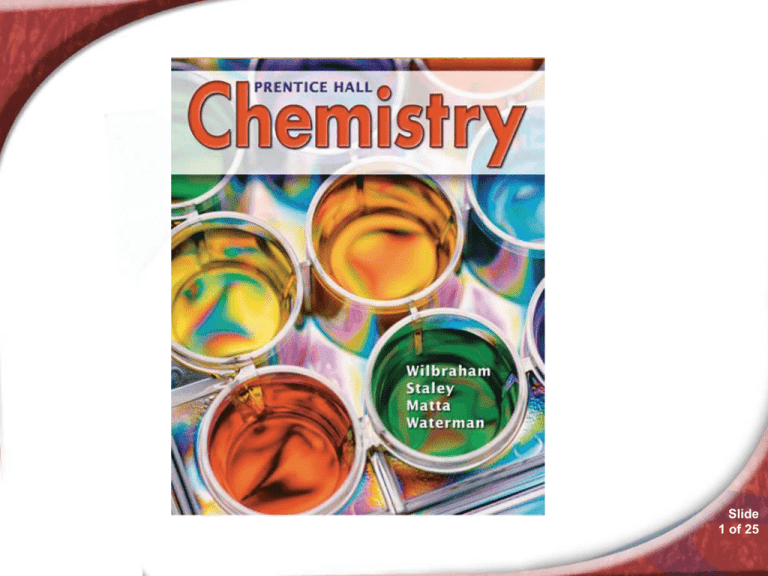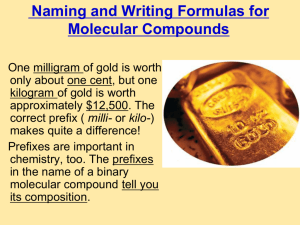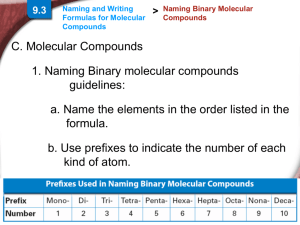
Chemistry 2.3
Slide
1 of 25
2.3
Elements and Compounds
> Distinguishing Elements and
Compounds
An element is the simplest form of matter that
has a unique set of properties.
A compound is a substance that contains two or
more elements chemically combined in a fixed
proportion.
Slide
2 of 25
© Copyright Pearson Prentice Hall
2.3
Elements and Compounds
> Distinguishing Elements and
Compounds
Compounds can be broken down into
simpler substances by chemical means,
but elements cannot.
Slide
3 of 25
© Copyright Pearson Prentice Hall
2.3
Elements and Compounds
> Distinguishing Elements and
Compounds
Breaking Down Compounds
A chemical change is a
change that produces matter
with a different composition
than the original matter.
When table sugar is
dehydrated, it goes through a
series of chemical changes.
Slide
4 of 25
© Copyright Pearson Prentice Hall
2.3
Elements and Compounds
> Distinguishing Elements and
Compounds
The final products of these chemical changes
are solid carbon and water vapor. The following
diagram summarizes the process.
Slide
5 of 25
© Copyright Pearson Prentice Hall
2.3
Elements and Compounds
> Distinguishing Elements and
Compounds
Properties of Compounds
In general, the properties of compounds
are quite different from those of their
component elements.
When the elements sodium and chlorine
combine chemically to form sodium
chloride, there is a change in composition
and a change in properties.
Slide
6 of 25
© Copyright Pearson Prentice Hall
Elements and Compounds
> Calcium
Calcium metal is used
as a reducing agent in
preparing other metals
such as thorium and
uranium, and as an
alloying agent for
aluminium, beryllium,
copper, lead and
magnesium alloys.
Slide
7 of 25
© Copyright Pearson Prentice Hall
Elements and Compounds
> Carbon
There are a number of pure
forms of this element
including graphite, diamond,
fullerenes and graphene.
Diamond is a colorless
transparent crystalline solid,
the hardest known material.
Graphite is black and shiny
but soft, and the nano-forms,
fullerenes and graphene
appear, in bulk, as black or
dark brown soot-like
powders
Slide
8 of 25
© Copyright Pearson Prentice Hall
Elements and Compounds
Industrially, oxygen is
produced on a large scale
from liquid air by liquefaction
and fractional distillation. In
the laboratory it can be
prepared by the electrolysis
of water or by adding
manganese(IV) oxide as a
catalyst to aqueous
hydrogen peroxide.
Oxygen is
•very reactive
•combines with most other
elements.
> Oxygen
•a component of many
organic compounds
•is essential for the aerobic
•necessary for combustion
•used in steel industry.
•used in the manufacture of
• nitric acid,
•hydrogen peroxide
•chloroethene (precursor to PVC)
•used in oxy-acetylene
welding and cutting of
metals.
•used in the treatment of
sewage and of effluent from
industry.
Slide
9 of 25
© Copyright Pearson Prentice Hall
Elements and Compounds
> Oxygen
Slide
10 of 25
© Copyright Pearson Prentice Hall
> Calcium Carbonate
Many of us encounter
calcium carbonate for the
first time in the school
classroom, where we use
blackboard chalk.
Elements and Compounds
Calcium carbonate, or
CaCO3, comprises more
than 4% of the earth’s crust
and is found throughout the
world.
Its most common natural
forms are;
•Chalk
•Limestone
•Marble
•Calcium carbonate is one of
the most useful and versatile
materials known to man.
As limestone, calcium
carbonate is a biogenic rock,
and is more compacted than
chalk.
As marble, calcium
carbonate is a coarsecrystalline, metamorphic
rock, which is formed when
chalk or limestone is
recrystallised under
conditions of high
temperature and pressure.
© Copyright Pearson Prentice Hall
Slide
11 of 25
2.3
Elements and Compounds
> Distinguishing Substances and
Mixtures
If the composition of a material is fixed,
the material is a substance. If the
composition of a material may vary, the
material is a mixture.
Slide
12 of 25
© Copyright Pearson Prentice Hall
2.3
Elements and Compounds
> Distinguishing Substances
and Mixtures
This flowchart
summarizes the
process for
classifying matter.
Slide
13 of 25
© Copyright Pearson Prentice Hall
Slide
14 of 25
© Copyright Pearson Prentice Hall
Practice Problems for Conceptual Problem 2.2
Problem Solving 2.19 Solve
Problem 19 with the help of an
interactive guided tutorial
Slide
15 of 25
© Copyright Pearson Prentice Hall
2.3
Elements and Compounds
> Symbols and Formulas
Chemists use chemical symbols to
represent elements, and chemical
formulas to represent compounds.
These chemical symbols were used in
earlier centuries.
Slide
16 of 25
© Copyright Pearson Prentice Hall
2.3
Elements and Compounds
> Symbols and Formulas
Each element is represented by a one or twoletter chemical symbol.
Slide
17 of 25
© Copyright Pearson Prentice Hall
2.3 Section Quiz.
Assess students’ understanding
of the concepts in Section 2.3.
Continue to:
-or-
Launch:
Section Quiz
Slide
18 of 25
© Copyright Pearson Prentice Hall
2.3 Section Quiz
1. Passing an electric current through a certain
substance produces oxygen and sulfur. This
substance cannot be a(n)
a. compound.
b. mixture.
c. element.
d. solution.
Slide
19 of 25
© Copyright Pearson Prentice Hall
2.3 Section Quiz
2. Which of the following is a mixture?
a. sodium chloride
b. carbon dioxide
c. sucrose
d. air
Slide
20 of 25
© Copyright Pearson Prentice Hall
2.3 Section Quiz.
3. The symbol for the element potassium is
a. K.
b. Po.
c. P.
d. Pt.
Slide
21 of 25
© Copyright Pearson Prentice Hall
END OF SHOW





